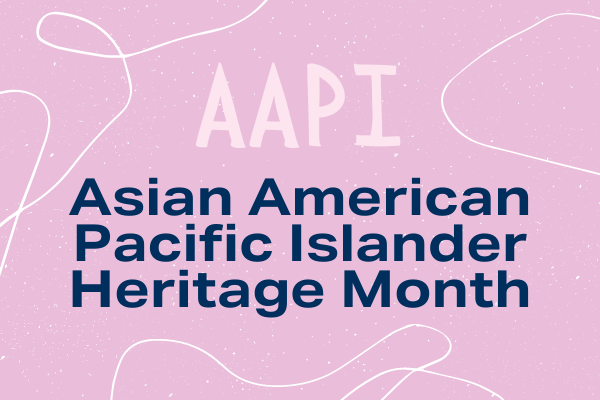Updated May 31, 2022
The History of Asian American Pacific Islander (AAPI) Month
Established in 1992, May is Asian American Pacific Islander Heritage Month – celebrating the traditions, culture, and history of Asian Americans and Pacific Islanders. The month of May was chosen to pay tribute to the arrival of the first Japanese immigrant to the United States on May 7, 1843, as well as the completion of the transcontinental railroad on May 10, 1868. Around 20,000 Chinese immigrants contributed to the construction of the railroad, which was the first railroad to connect the Atlantic and Pacific coasts.
Where did the term Asian American come from?
While the term “Asian American” is now primarily used as a demographic marker, this was not its original intended use. The term was coined in 1968 by UC Berkeley student activists Emma Gee and Yuji Ichioka as a strategy to build political power.
Inspired by the Black Power Movement and the American Indian movement, Gee and Ichioka wanted to create a campus organization that would unite different communities of Asian descent resulting in the creation of the Asian American Political Alliance (AAPA). AAPA was UC Berkeley’s first pan-Asian American grassroots organization that engaged in progressive activism and pushed for the establishment of an ethnic studies department. Following the 1980s, the term was expanded to Asian American and Pacific Islander (AAPI), to include people from the Pacific Islands of Melanesia, Micronesia, and Polynesia.
The term was broadened in hopes of being more inclusive but has been criticized for creating an image of Asian Americans as a monolithic group and erasing the diversity among the Asian diaspora. The Asian diaspora is made up of roughly 50 ethnic groups and over 100 languages, with vast religious, class, and ideological differences.
The “Model Minority” Myth
The generalization of Asian American’s diversity has led to the emergence of the “model minority” myth, a harmful stereotype that depicts all Asian Americans as successful and well-off, especially in comparison to other minority groups. The model minority myth allows White people to ignore the role racism plays in the struggles of other racial and ethnic minority groups and instead blames their positions on cultural values.
This ultimately works to create a divide between the AAPI community and other Black, Indigenous and people of color (BIPOC) communities. This myth is also harmful to underrepresented groups of the AAPI community such as Native Hawaiians and Pacific Islanders whose struggles and specific needs are not being addressed. The AAPI category also does not reflect disparities within different ethnic groups, including educational attainment and income levels. For instance, there are significant disparities in degree completion among those who identify as AAPI. According to the Postsecondary National Policy Institute, among Native Hawaiian and Pacific Islanders over the age of 24, 28 percent have completed an associate degree or higher compared to 62 percent of AAPI adults 24 and older.
#StopAsianHate
During the ongoing COVID-19 pandemic, the U.S. has seen a drastic increase in anti-Asian hate crimes. These current acts of violence upon the AAPI community are not new, but instead they are reflective of the long-standing history of racist and violent treatment of Asian Americans and Asians in the U.S. This treatment is evident in the 1882 Chinese Exclusion Act, the incarceration of Japanese descendants during World War II, the increase in hate crimes against Muslims, Sikhs, and South Asians following the September 11th terrorist attacks and the drastic rise of deportations in the Southeast Asian community. This history of Asian American violence is rooted in the United States’ foundation of White supremacy, which has framed Asians as “others” and a threat to national security and White people’s professions.
With the recent waves of anti-Asian hate crimes, though, there has also been the emergence of the #StopAsianHate movement. This movement has prompted thousands of individuals from across the country to rally together protesting the unfair treatment of the AAPI community during the ongoing COVID-19 pandemic and beyond. The #StopAsianHate movement has also drawn attention to the long history of racism that the AAPI community has faced in the United States. It has brought awareness to the fact that current anti-Asian hate crimes are not a singular event but instead a reflection of anti-Asian rhetoric that has been pervasive throughout U.S. history.
This May, it is important that we celebrate the AAPI community and recognize the diversity as well as inequality within different ethnic groups. However, among those differences, there are also commonalities as the AAPI community continues to seek unity and justice in America. At Tahirih we believe it is important to recognize the diversity within the AAPI community as well as acknowledge the historical struggles the AAPI community has faced. While the month of May is AAPI Heritage Month, at Tahirih we are committed to honoring the AAPI community and their fight for justice in the work that we do year-round.
Resources:
Social Media Accounts to Follow:
- @stopaapihate: Dedicated towards addressing anti-Asian hate during the pandemic.
- @aapiwomenlead: Centers the voices and experiences of Asian American and Pacific Islander women and girls.
- @aaldef: Protects and promotes the civil rights of Asian Americans.
- @AAAJ_AAJC: Fights for civil rights and empowers Asian Americans to create a more just America for all.
- SAALTweets: Works on policy analysis and advocacy on issues affecting the South Asian community.
Articles and Resources:
- “In 1968, These Activists Coined the Term ‘Asian American’ – And Helped Shape Decades of Advocacy” by Anna Purna Kambhampaty
- “30 Revolutionary Asians and Pacific Islanders to Celebrate for AAPI Heritage Month” by NegraBohemian.com
- “We Are More” by Amanda Phingbodhipakkiya
- “LEARN from stories: Resistance is our Heritage” by AAPIsRising.org
- “On Being Black and Asian in America” by Kimiko Matsuda-Lawrence
- “12 AAPI Parents on Raising Kids with Cultural Pride” by Kimmie Fink
Books and Media:
- Concepcion: An Immigrant Family’s Fortune by Albert Samaha
- Crying in H-Mart by Michelle Zauner
- Tofu Takes Time by Helen H. Wu
- Minari by Lee Isaac Chung
- The Long Goodbye by Riz Ahmed
- Asian Enough from the LA Times
- Indian-ish: Recipes and Antics from a Modern American Family by Priya Krishna
Citations:
- Berkeley Historical Plaque Project, “Asian American Political Alliance (AAPA),” Berkeleyplaques.org
- Britannica, “American Indian Movement,” Britannica.com
- HISTORY, “How the Black Power Movement Influenced the Civil Rights Movement,” History.com
- TIME, “How One Woman’s Story Led to the Creation of Asian Pacific American Heritage Month,” Time.com
- The Postsecondary National Policy Institute, “Asian American and Pacific Islander Students in Higher Education,” PNPI.org
- The Washington Post, “The term ‘Asian American’ was meant to create a collective identity. What does that mean in 2018?”, Washingtonpost.com
- Today, “Do I count as ‘Asian American’? What the history behind the term taught me,” Today.com
- USA Today, “Asian American activists are demanding equal civil rights, better education in schools after Asian hate attacks,” Usatoday.com
- Vox, “The inadequacy of the term “Asian American”,” Vox.com


